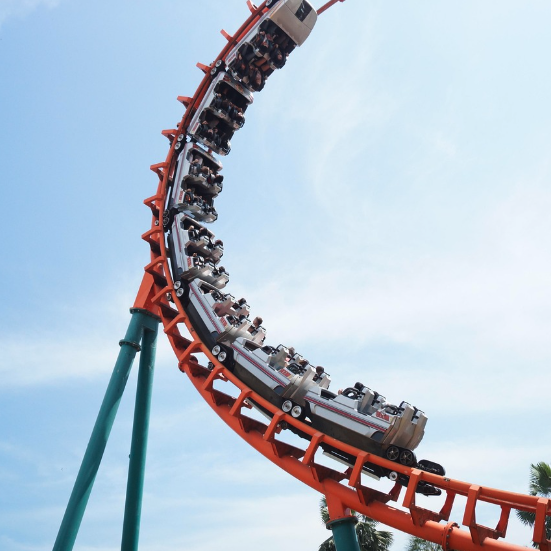Roller Coaster Physics: A High School Lesson Plan for Amusement Park Field Trips
🎢 Where Fun Meets Physics 🎢
Looking for a hands-on physics lesson plan that brings Newton’s Laws, energy transformations, and circular motion to life? This amusement park physics field trip gives high school students a thrilling way to explore real-world STEM concepts. This guide includes pre-trip lessons, on-site activities, and a Goosechase scavenger hunt that turns the amusement park into a physics laboratory.
Overview: Why Teach Physics at an Amusement Park?
Hook your high school students into learning by connecting classroom physics with the adrenaline of roller coasters, free falls, and spinning rides. In this lesson, students will apply Newton’s Laws, energy transformations, and circular motion to real-world experiences at the amusement park. This plan gives physics teachers a roadmap for guiding students before, during, and after the trip.
Grade: 9 - 12
Subject: Physics
Learning Objectives
During this lesson, students will:
- Apply Newton’s Laws of Motion to real-life examples on amusement park rides.
- Analyze energy transformations (kinetic, potential, thermal) during ride experiences.
- Explain the role of centripetal force and acceleration in circular motion rides.
- Collect, record, and interpret data from field observations.
- Collaborate with peers to solve problems and communicate findings.
Materials Needed
- Mobile devices (tablets, phones, or laptops) with the Goosechase app installed
- Field notebooks or worksheets
- Stopwatch or timing app
- Calculator
- Safety-appropriate writing tools (clipboards, pencils)
Pre-Trip Classroom Preparation
Setting the Stage: Why Physics at the Park?
- Begin class with a video montage of amusement park rides to capture student interest.
Pose a few thought-provoking questions:
- Why don’t we fly out of our seats on a looping roller coaster?
- How do rides keep people safe at such high speeds?
- Why does your stomach drop on a free-fall tower?
Explain that the field trip will let them answer these questions using real rides as physics “labs.”
Review of Key Concepts
Newton’s Laws of Motion
- Examples: bumper cars (action-reaction), roller coaster launch (force = mass × acceleration).
Energy Transformations
- Potential to kinetic energy on a coaster hill.
Circular Motion & Centripetal Force
- How spinning rides keep students pressed into their seats.
Acceleration & G-Forces
- Relating acceleration to the sensations they’ll feel on rides.
Data Collection Skills
- Teach students how to measure and record ride times using a stopwatch or phone app.
- Practice estimating heights and speeds using scaling (for example, timing a toy car down a ramp and extrapolating).
- Complete example calculations with mock data to ensure understanding of mathematical processes.
Using Goosechase in Your Physics Lesson
Create an Experience on the Goosechase app with a series of Missions focussed on physics.
Develop Missions that require students to demonstrate their understanding of what they have learned. Example Missions:
- Newton in Action: Record a video explaining which of Newton’s Laws is demonstrated on a ride.
- Energy Exchange: Take a photo of a roller coaster and describe where potential and kinetic energy are greatest.
- Spin Science: Measure the time for one rotation of a spinning ride and calculate angular velocity.
- Free Fall Fun: Estimate the height of a drop tower and calculate potential energy at the top.
- Centripetal Force: Record yourself describing how you stay in your seat during a loop or turn.
- Find Example Missions in the Goosechase Templates below
- Adapt the difficulty of the Missions based on the proficiency levels of your students to keep the activity inclusive and engaging for everyone.
- Prepare hints or resources that might help students solve the Missions if needed.
- Run your Experience during one class period or longer
- Divide students into teams and assign each team a mobile device with the app, or have students complete the scavenger hunt individually.
App Set Up
- Dedicate time to ensuring all students have the Goosechase app downloaded and have joined your Experience to avoid any tech issues the morning of your visit.
Amusement Park Visit Activities
Upon Arrival at the Amusement Park
- Gather students for a brief orientation
- Review behavioral and safety expectations for the trip.
- Review the amusement park map, highlighting any important areas
- Remind students to balance fun with data collection and observation.
- Emphasize the significance of teamwork and cooperation during the scavenger hunt.
- Provide them with checklists or worksheets (ride name, data table, notes column) so they are ready to record during the trip.
- Encourage students to ask questions to the staff and take advantage of any educational resources offered.
Scavenger Hunt Exploration
- Students explore the amusement park in their teams, completing various tasks and challenges related to the rides.
- Encourage students to use their observation skills to answer questions and complete tasks on the Goosechase mission list that acts as a digital checklist or worksheet.
- Students complete missions on Goosechase that prompt them to measure, observe, and reflect on rides.
- Documentation of student observations are recorded within the Goosechase app and automatically saved to their camera roll.
- Teachers circulate to support learning connections.
Debrief and Reflection
- Group discussion: Which rides best illustrated the concepts?
- Data analysis: Calculate forces, accelerations, and energy conversions using collected data.
Post-Trip Reflection & Data Analysis
Group Discussion: Making Connections
- Students return from the field trip and gather in small groups (3–5 students) with their notes, worksheets, and Goosechase submissions.
- Teacher Prompts:
- “Which ride gave you the clearest example of Newton’s Laws?”
- “On which ride did you most strongly feel energy transformations happening?”
- “Where did you experience the greatest acceleration and how do you know?”
- “Which ride surprised you the most in terms of physics?”
Group Activity:
- Each group selects one ride that best illustrates a physics principle.
- They create a short poster or whiteboard sketch that shows:
- A diagram of the ride
- Forces acting on riders
- Points of greatest potential and kinetic energy
- Observed accelerations or sensations
- Share-Out: Each group gives a 2–3 minute recap to the class.
Data Analysis Workshop
- Objective: Students turn raw field data (times, heights, observations) into meaningful calculations.
- Example Tasks:
- Forces & Acceleration: Using measured times and estimated distances:
- Calculate average speed
- Calculate acceleration
- Energy Transformations
- Estimate potential energy at the top of a hill
- Compare to calculated kinetic energy at the bottom
- Discuss how close values are, and what accounts for energy loss (sound, heat, friction).
- Centripetal Force
- For spinning rides:
- Calculate the speed
- Calculate centripetal acceleration
- Determine centripetal force
- For spinning rides:
- Forces & Acceleration: Using measured times and estimated distances:
Whole-Class Synthesis
- Guided Reflection Prompts:
- “Which formulas were easiest to apply to your ride data? Which were hardest?”
- “How do your calculations connect with the sensations you felt on the rides?”
- “What real-world challenges did you encounter when trying to collect scientific data outside the classroom?”
- “How did energy conservation or Newton’s Laws help explain safety design in rides?”
- Encourage students to see how math validated their experiences and how their bodies became physics detectors.
Optional Follow-Up Activities
Reflection Essay
- Students choose one ride and write a 1–2 page essay. They must describe their experience and connect it to at least three physics principles (e.g., Newton’s Laws, energy transformations, centripetal force). Include both what they felt and what the physics explains.
Visual Creation
- Students draw and label a diagram of a chosen ride. They should show key forces (gravity, normal force, centripetal force) and mark where potential and kinetic energy are greatest. A short written explanation accompanies the diagram.
Group Presentation
- In small groups, students compare two or more rides. Their presentation should explain at least three physics concepts per ride, include data or observations from the field trip, and use a visual aid (poster, slides, or Goosechase submissions).
Assessment
- Participation in Goosechase Missions.
- Accuracy of data collection and calculations.
- Quality of individual reflections (clarity, physics application).
- Group presentations assessed with rubric (teamwork, accuracy, depth).Ready Made Experience Templates to Try
Ready-Made Goosechase Templates

Physics in Motion: Amusement Park Challenge
Bring students on a fields trip to the amusement park and explore the thrills of physics in action!
Get your own copy!

Physics in Motion: Amusement Park Challenge
Bring students on a fields trip to the amusement park and explore the thrills of physics in action!
Keep the Learning Rolling 🎢
Not heading to an amusement park? Bring the excitement to your classroom or schoolyard with these hands-on physics Goosechase Experiences — perfect for sparking curiosity, motion, and fun right where you are!
More Where That Came From:
This is just one of many ready-to-run Goosechase lesson plans we’ve created. Explore them all here and keep your students learning, laughing, and engaged year-round.
Want a copy of this lesson plan to use with your class?
FAQs
How do you teach physics at an amusement park?
Amusement parks are full of real-world examples of motion, energy, and force. Teachers can guide students to observe ride mechanics, measure time and speed, and apply Newton’s Laws and energy principles to what they experience. Using tools like data tables, stopwatches, and the Goosechase app helps students collect measurements, answer questions, and reflect on physics concepts in real time.
What physics concepts can be explored on roller coasters?
Roller coasters demonstrate several key physics ideas, including potential and kinetic energy, acceleration, g-forces, centripetal force, and Newton’s Laws of Motion. Students can analyze how energy transfers as the coaster climbs and drops, measure the speed at different points, and explore why riders stay securely in their seats through loops and turns.
What makes an amusement park a good field trip for high school physics students?
Amusement parks turn abstract physics theories into hands-on experiences. Students can feel acceleration, observe energy changes, and witness forces in action. This real-world application improves understanding, boosts engagement, and supports deeper learning. It’s also ideal for collaborative activities like scavenger hunts, team challenges, and data collection missions.
How can Goosechase be used to enhance a physics field trip?
Goosechase makes the field trip interactive by turning learning objectives into Missions students complete on their mobile devices. Physics tasks, such as measuring rotation time, identifying energy transformations, or recording examples of Newton’s Laws, are built into a scavenger hunt format. Responses are automatically saved, making reflection and assessment easier for teachers.
What should students bring for a physics-focused amusement park visit?
Students should bring a mobile device with Goosechase installed, a notebook or worksheet for data collection, a stopwatch or timing app, and basic tools like pencils or clipboards. Comfortable walking shoes, water, and sunscreen are also helpful, since activities involve moving around the park, observing rides, and recording measurements.
What is Goosechase EDU?
Goosechase is an online platform that helps educators create and run interactive learning experiences in their classrooms and beyond. Sign up and try creating an Experience, or contact us to learn more about our school and district-wide solutions!





